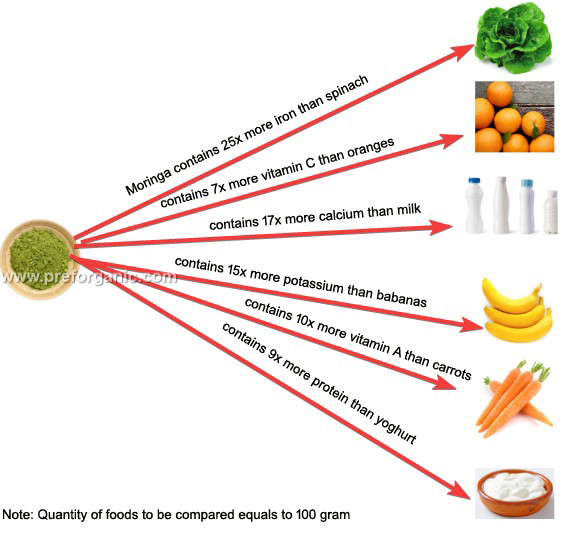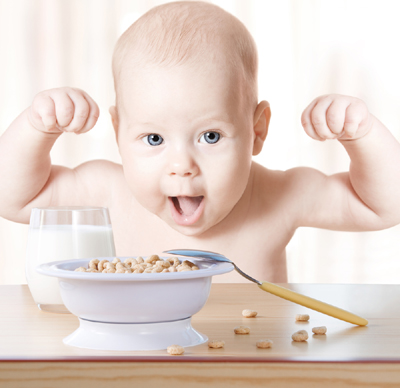Super Food Benefits of Moringa Oleifera Leaves Outweigh Those of Spinach, Milk, Carrots, Bananas, Yogurt and Beef, Without Any Critical Side Effects
Popeye, the Sailor, might have replaced spinach long ago had he known benefits of moringa oleifera leaves. Had Bluto taken moringa leaves, the spinach couldn’t stand against benefits of moringa.
Moringa oleifera tree is native to Pakistan, India, sub-Himalayan regions, Arabia and Africa. The folk doctors and common farmers have been using different parts of moringa tree for last fifteen centuries.
I recall my grandmother frequently cooking moringa flowers and pods, while my grandfather’s favorites have always been moringa leaves.
The biologists and chemists have started to analyze moringa and its various parts a couple of decades. Before that benefits of moringa were just a personal experience or secret of the folk doctors. The local people have naturally given different names to this tree as ‘suhanjana,’ ‘drumstick tree’ ‘Horseradish tree,’ ‘mothers best friend,’ and ‘Ben oil tree.’
But Popeye, the Sailor, didn’t know it.
Comparing Benefits of Moringa with Other Healthy Foods
The latest researches have proved that moringa leaves contain more protein, carbohydrates, omega fats, calcium, Vitamin C, Riboflavin, Niacin and Vitamin B6 than equal quantity of spinach. However, the same quantity of spinach contains more magnesium, potassium, Vitamin A, Vitamin K and Folate (B9). Yet overall benefits of moringa oleifera leaves beat spinach as a super food.
Not only spinach, when we compare benefits of moringa, depending upon its nutrient composition, we find it better than milk, yoghurt, oranges and carrots as well. “Moringa is said to provide 7 times more vitamin C than oranges, 10 times more vitamin A than carrots, 17 times more calcium than milk, 9 times more protein than yoghurt, 15 times more potassium than bananas and 25 times more iron than spinach." The “beef has only 2 mg of iron while moringa leaf powder has 28 mg of iron.”

USDA’s Chemical Analysis of Spinach vs Moringa Leaves
The United Stated Department of agriculture is famous for giving detailed chemical analysis of various food related products. You can read the list of ingredients of moringa leaves by clicking here and come back to the story of Popeye the Sailor and Bluto had they known empowering benefits of moringa over spinach.
The USDA has detailed the following nutrient composition of spinach.
| Nutrient | Unit | 1Value per 100 g | 1 cup = 30.0g |
|---|---|---|---|
| Water | g | 91.4 | 27.42 |
| Energy | kcal | 23 | 7 |
| Energy | kJ | 97 | 29 |
| Protein | g | 2.86 | 0.86 |
| Total lipid (fat) | g | 0.39 | 0.12 |
| Ash | g | 1.72 | 0.52 |
| Carbohydrate, by difference | g | 3.63 | 1.09 |
| Fiber, total dietary | g | 2.2 | 0.7 |
| Sugars, total | g | 0.42 | 0.13 |
| Sucrose | g | 0.07 | 0.02 |
| Glucose (dextrose) | g | 0.11 | 0.03 |
| Fructose | g | 0.15 | 0.04 |
| Galactose | g | 0.1 | 0.03 |
| Minerals | |||
| Calcium, Ca | mg | 99 | 30 |
| Iron, Fe | mg | 2.71 | 0.81 |
| Magnesium, Mg | mg | 79 | 24 |
| Phosphorus, P | mg | 49 | 15 |
| Potassium, K | mg | 558 | 167 |
| Sodium, Na | mg | 79 | 24 |
| Zinc, Zn | mg | 0.53 | 0.16 |
| Copper, Cu | mg | 0.13 | 0.039 |
| Manganese, Mn | mg | 0.897 | 0.269 |
| Selenium, Se | µg | 1 | 0.3 |
| Vitamins | |||
| Vitamin C, total ascorbic acid | mg | 28.1 | 8.4 |
| Thiamin | mg | 0.078 | 0.023 |
| Riboflavin | mg | 0.189 | 0.057 |
| Niacin | mg | 0.724 | 0.217 |
| Pantothenic acid | mg | 0.065 | 0.02 |
| Vitamin B-6 | mg | 0.195 | 0.059 |
| Folate, total | µg | 194 | 58 |
| Folic acid | µg | 0 | 0 |
| Folate, food | µg | 194 | 58 |
| Folate, DFE | µg | 194 | 58 |
| Choline, total | mg | 19.3 | 5.8 |
| Betaine | mg | 102.6 | 30.8 |
| Vitamin A, RAE | µg | 469 | 141 |
| Carotene, beta | µg | 5626 | 1688 |
| Vitamin A, IU | IU | 9377 | 2813 |
| Lycopene | µg | 0 | 0 |
| Lutein + zeaxanthin | µg | 12198 | 3659 |
| Vitamin E (alpha-tocopherol) | mg | 2.03 | 0.61 |
| Tocopherol, gamma | mg | 0.18 | 0.05 |
| Vitamin K (phylloquinone) | µg | 482.9 | 144.9 |
| Lipids | |||
| Fatty acids, total saturated | g | 0.063 | 0.019 |
| 14:00 | g | 0.01 | 0.003 |
| 16:00 | g | 0.049 | 0.015 |
| 18:00 | g | 0.004 | 0.001 |
| Fatty acids, total monounsaturated | g | 0.01 | 0.003 |
| 16:1 undifferentiated | g | 0.005 | 0.002 |
| 18:1 undifferentiated | g | 0.005 | 0.002 |
| Fatty acids, total polyunsaturated | g | 0.165 | 0.05 |
| 18:2 undifferentiated | g | 0.026 | 0.008 |
| 18:3 undifferentiated | g | 0.138 | 0.041 |
| Phytosterols | mg | 9 | 3 |
| Amino Acids | |||
| Tryptophan | g | 0.039 | 0.012 |
| Threonine | g | 0.122 | 0.037 |
| Isoleucine | g | 0.147 | 0.044 |
| Leucine | g | 0.223 | 0.067 |
| Lysine | g | 0.174 | 0.052 |
| Methionine | g | 0.053 | 0.016 |
| Cystine | g | 0.035 | 0.011 |
| Phenylalanine | g | 0.129 | 0.039 |
| Tyrosine | g | 0.108 | 0.032 |
| Valine | g | 0.161 | 0.048 |
| Arginine | g | 0.162 | 0.049 |
| Histidine | g | 0.064 | 0.019 |
| Alanine | g | 0.142 | 0.043 |
| Aspartic acid | g | 0.24 | 0.072 |
| Glutamic acid | g | 0.343 | 0.103 |
| Glycine | g | 0.134 | 0.04 |
| Proline | g | 0.112 | 0.034 |
| Serine | g | 0.104 | 0.031 |
| Others | |||
| Luteolin | mg | 0.7 | 0.2 |
| Kaempferol | mg | 6.4 | 1.9 |
| Myricetin | mg | 0.3 | 0.1 |
| Quercetin | mg | 4 | 1.2 |
When we compare results of spinach and moringa leaves’ composition provided by the USDA, we find both supplying the most important minerals and energies which otherwise our bodies may not create or at least absorb.
| Nutrient | Moringa Leaves | Raw Spinach |
|---|---|---|
| Protein | 9.4 g | 2.86 g |
| Fat | 1.4 g | 0.39 g |
| Fiber | 2 g | 2.2 g |
| Carbohydrates | 8.28 g | 3.63 g |
| Calcium | 185 mg | |
| Iron | 4 mg | 2.71 mg |
| Potassium | 337 mg | 558 mg |
| Magnesium | 42 mg | 79 mg |
| Vitamin A | 378 RAE | 469 RAE |
| Vitamin C | 51.7 mg | 28.1 mg |
| Thiamin | 0.257 mg | 0.078 mg |
| Riboflavin | 0.66 mg | 0.189 mg |
| Niacin | 2.22 mg | 0.195 |
| Folate (B9) | 40 mcg | 194 mcg |
The benefits of moringa oleifera leaves have not only got attention of the USDA but also the World Health Organization to undertake scientific researches on moringa tree. You can find various medical and nutritional journals documenting benefits of moringa oleifera leaves and publishing. Some Non-Government Organizations like Educational Concerns for Hunger Organization, Trees for Life, and Church World Service have been advocating moringa being a natural nutritional wonder for babies as well as adults.
By: Saqib Ali Ateel
What are iron fortified foods?
Share Your Story of Moringa Here
You are welcome with your point of view, your personal story of using Moringa or even new research which refutes or alleviates moringa benefits. You are requested to share it with our visitors.
What's New?
-
What are iron fortified foods?
Iron fortified foods contain additional iron to help prevent deficiencies and support overall health, particularly in children and pregnant women. -
What are fortified foods?
What are fortified foods? How are they different from staple and common everyday foods? -
Baby Organic Food: “To be, or not to be, that is the question”
Baby organic food is free from insecticides, weedicides and residues of synthetic fertilizers thus much safer for babies

DOWNLOAD!



